
The Araceae are a family of monocotyledonous flowering plants in which flowers are borne on a type of inflorescence called a spadix. The spadix is usually accompanied by, and sometimes partially enclosed in, a spathe or leaf-like bract. Also known as the arum family, members are often colloquially known as aroids. This family of 114 genera and about 3750 known species is most diverse in the New World tropics, although also distributed in the Old World tropics and northern temperate regions.

In botany, a bract is a modified or specialized leaf, especially one associated with a reproductive structure such as a flower, inflorescence axis or cone scale. Bracts are often different from foliage leaves. They may be smaller, larger, or of a different color, shape, or texture. Typically, they also look different from the parts of the flower, such as the petals or sepals. The state of having bracts is referred to as bracteate or bracteolate, and conversely the state of lacking them is referred to as ebracteate and ebracteolate, without bracts.
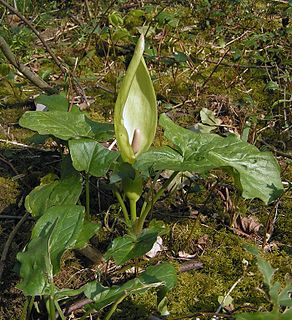
Arum maculatum is a common woodland plant species of the family Araceae. It is widespread across most of Europe, as well as Turkey and the Caucasus. It is known by an abundance of common names including snakeshead, adder's root, arum, wild arum, arum lily, lords-and-ladies, devils and angels, cows and bulls, cuckoo-pint, soldiers diddies, priest's pintle, Adam and Eve, bobbins, naked girls, naked boys, starch-root, wake robin,friar's cowl, sonsie-give-us-your-hand, jack in the pulpit and cheese and toast. The name "lords-and-ladies" and other gender-related names refer to the plant's likeness to male and female genitalia symbolising copulation.

Zantedeschia is a genus of eight species of herbaceous, perennial, flowering plants in the family Araceae, native to southern Africa from South Africa north to Malawi. The genus has been introduced on all continents except Antarctica. Common names include arum lily for Z. aethiopica and calla and calla lily for Z. elliottiana and Z. rehmannii, although members of the genus are neither true lilies of Liliaceae, true Arums, or true Callas. They are also often confused with Anthurium. The colourful flowers and leaves of both species and cultivars are greatly valued and commonly grown as ornamental plants.

Cocoyam is a common name for more than one tropical root crop and vegetable crop belonging to the Arum family and may refer to:
Dragonwort is a common name for a plant which may refer to:

Peltandra, the arrow arums, is a genus of plants in the family Araceae. It is native to the eastern United States, eastern Canada, and Cuba.
- Peltandra sagittifolia - (Michx.) Morong - Spoon flower or the white arrow arum - southeastern US from eastern Louisiana to Virginia
- Peltandra virginica(L.) Schott - Arum arrow - Cuba, Quebec, Ontario, Oregon, California, Washington; eastern US from Maine to Florida, west to Texas, Kansas, and Minnesota
- †Peltandra primaeva – Eocene, Golden Valley Formation, North Dakota, USA
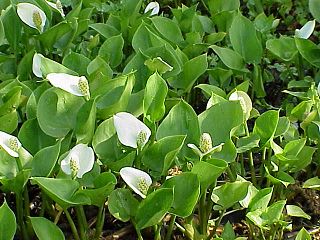
Calla is a genus of flowering plant in the family Araceae, containing the single species Calla palustris.

Arum is a genus of flowering plants in the family Araceae, native to Europe, northern Africa, and western and central Asia, with the highest species diversity in the Mediterranean region. Frequently called arum lilies, they are not closely related to the true lilies Lilium. Plants in closely related Zantedeschia are also called "arum lilies".
Jack in the pulpit may refer to:
Penis plant is a common name for several plants and may refer to:

Arum italicum is a species of flowering herbaceous perennial plant in the family Araceae, also known as Italian arum and Italian lords-and-ladies. It is native to the Mediterranean region. It is also naturalized in Great Britain, the Netherlands, Crimea, Caucasus, Canary Islands, Madeira, Azores, Argentina and in scattered locations in the United States.

Helicodiceros muscivorus, the dead horse arum lily, is an ornamental plant native to Corsica, Sardinia and the Balearic Islands. It is the only species in the genus Helicodiceros. Within the family Araceae the plant is part of the subfamily Aroideae.
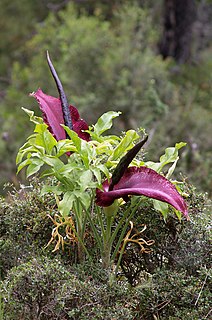
Dracunculus vulgaris is a species of aroid in the genus Dracunculus and is known variously as the common dracunculus, dragon lily, dragon arum, the black arum, the voodoo lily, the snake lily, the stink lily, the black dragon, the black lily, dragonwort, and ragons. In Greece, part of its native range, the plant is called drakondia, the long spadix being viewed as a small dragon hiding in the spathe.
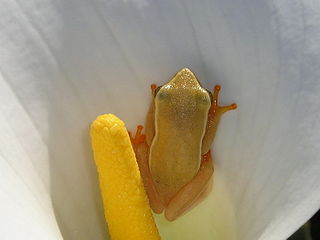
The arum frog, Horstock's arum-frog, arum lily frog, or Horstock's reed frog is a species of frog in the family Hyperoliidae. It is endemic to South Africa.
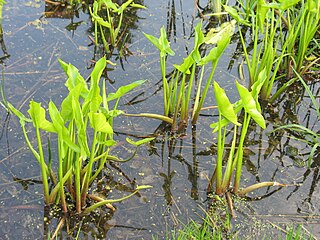
Peltandra virginica is a plant of the arum family known as green arrow arum and tuckahoe. It is widely distributed in wetlands in the eastern United States, as well as in Quebec, Ontario, and Cuba. It is common in central Florida including the Everglades and along the Gulf Coast. Its rhizomes are tolerant to low oxygen levels found in wetland soils. It can be found elsewhere in North America as an introduced species and often an invasive plant.
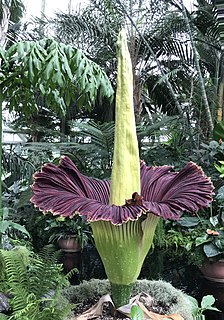
Amorphophallus titanum, the titan arum, is a flowering plant with the largest unbranched inflorescence in the world. The titan arum's inflorescence is not as large as that of the talipot palm, Corypha umbraculifera, but the inflorescence of the talipot palm is branched rather than unbranched. The species is endemic to Sumatra.

Puccinia sessilis is a fungal plant pathogen, also known as Arum Rust or Ransons Rust. It commonly infects Arum maculatum and Allium ursinum causing yellow to orange circular patches on leaves. On the underside it produces raised orange aecia commonly covered in spores. It is common in Eurasia in the Spring.

Arum palaestinum is a species of flowering herbaceous perennial plant in the family Araceae and the genus Arum It is native to the Levant and other parts of the Mediterranean Basin, and has been naturalized in North America, North Africa, Europe, Western Asia, and Australia The family Araceae includes other well-known plants such as Anthurium, Caladium, and Philodendron.

Harmankaya Nature Park is a nature park located in Termal district of Yalova Province, northwestern Turkey.
















